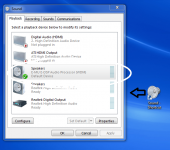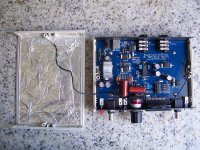Copper tape works well too as a shield, if you can't get mumetal or don't want to work it.
Andrew
Copper foil tape is great for RFI shielding, but it won't do anything for EMI. Only mumetal or steel is good for that. Using both is even better. The copper foil has to be grounded to be effective whereas the mumetal does not.
AndrewL, you call this simple.
What does it do?
What does it mena?
what do I do with it?
As AndrewL explained, you need to rename the file to *.session . These file are configuration files for the soundcard EMU 1212m. If you do not have a soundcard like this, you cannot do anything with these files. If you do have an EMU 1212m soundcard, press the button "open session" and select the files posted here (by AndrewL or Me)
These files were posted in a request to have an "identical" setup. You need of course to buy the same sound card to have this. Hope this makes everything clear.
Copper foil tape is great for RFI shielding, but it won't do anything for EMI. Only mumetal or steel is good for that. Using both is even better. The copper foil has to be grounded to be effective whereas the mumetal does not.
In practice that doesn't appear to be the case, although I hear what you are saying, I get a significant reduction in 50Hz with the copper tape and, as you say, it has to be grounded.
Andrew
As AndrewL explained, you need to rename the file to *.session . These file are configuration files for the soundcard EMU 1212m. If you do not have a soundcard like this, you cannot do anything with these files. If you do have an EMU 1212m soundcard, press the button "open session" and select the files posted here (by AndrewL or Me)
These files were posted in a request to have an "identical" setup. You need of course to buy the same sound card to have this. Hope this makes everything clear.
Yes, spot on Wim! Andrew, you can find the 'open session' button for the 1212m PatchMix controller in the manual or via the help. As Wim says, rename the file I attached from AudioTester.txt to AudioTester.session or use one of his zip'd files which should have the correct extension. I had to rename the file to attach it or forum software wouldn't have let me post it, zipping files up into a package is another way around this problem.
Loading the file into PatchMix will correctly configure the sound card, once you have done that its just a case of connecting up the cables from the sound card to Pete's box.
Andrew
Hello,
Now I see said the blind man! I was scratching my butt before, thinking what is this session stuff.
I had no clue what a session type file was. It is the configuration file used by the patch mix “mixer”. I will give it a spin. I was using the RMAA sessions with a little tweaking.
Thanks
DT
Now I see said the blind man! I was scratching my butt before, thinking what is this session stuff.
I had no clue what a session type file was. It is the configuration file used by the patch mix “mixer”. I will give it a spin. I was using the RMAA sessions with a little tweaking.
Thanks
DT
I have no sound from my sound card. No music, no BBC iPlayer sound track.
What did the zip files do?
Wim,
why do you think I am asking for details of setting up a 1212?
Because I have them fitted to both my desktops. One on XP and one on 7.
Now my 7 version won't play any sound !
What did the zip files do?
Wim,
why do you think I am asking for details of setting up a 1212?
Because I have them fitted to both my desktops. One on XP and one on 7.
Now my 7 version won't play any sound !
I have no sound from my sound card. No music, no BBC iPlayer sound track.
What did the zip files do?
Wim,
why do you think I am asking for details of setting up a 1212?
Because I have them fitted to both my desktops. One on XP and one on 7.
Now my 7 version won't play any sound !
If I understand you correctly, you want to use the EMU 1212soundcard also as the "default" soundcard for your windows (so you here sound like windows starting up and new email sound).
This is not recommended, because Windows WILL interfere with your measurements, and you cannot use ASIO drivers (Windows need Wave drivers, ASIO is not supported).
I use the integrated soundcard of my PC for Windows sounds, and use the EMU 1212 exclusively for measurements.
I have attached 2 sessions for WAVE configuration. With these you should be able to hear windows sounds (take the 48Khz version).See also the sreenshot for the Windows 7 sound config.
It is recommended you load the ASIO config (files in previous post) if you want to do serious measurements.
Attachments
In practice that doesn't appear to be the case, although I hear what you are saying, I get a significant reduction in 50Hz with the copper tape and, as you say, it has to be grounded.
Andrew
I was disappointed that the self stick mu metal sheet I got at a surplus store wasn't sticking very well. Corners had lifted, so I had to break out the aluminum duct tape which has some kind of freakishly strong adhesive on it to hold the mu metal down. I didn't want an shorts on the board!
Then, after I plugged it in, it wasn't working and investigation revealed that I'd put one of the opamps in backwards! Ack! That chip is now ruined since it still doesn't work after putting it in the right way (and it gets warm....). So, yet another order from Mouser.... sigh.
I downloaded Arta but see the same problem with it that I have with Audio Tester.
I'm using ASIO (although I see the same problem with other drivers) and occasionally get a dropout of the output audio. this totally screws up my FFTs.
I'm using ASIO (although I see the same problem with other drivers) and occasionally get a dropout of the output audio. this totally screws up my FFTs.
Latency problems are common on later versions of Windows with various sound cards, I think the windows driver framework is to blame, too heavywieght, but this is only speculation. If you imagine all the extra guff that allows standby, hibernate, hot plugging and so on that windows has.....well I can see the trade offs here, can you?
The EMU 1212m and the bigger 1616m don't use Windows drivers, they roll their own; this seems much more reliable in terms of drop outs. Just my experiences.
Andrew
The EMU 1212m and the bigger 1616m don't use Windows drivers, they roll their own; this seems much more reliable in terms of drop outs. Just my experiences.
Andrew
The machine in question is running XP pro. I thought about getting a copy of 7 to try on it, but doubt it would work any better.
OK, what in the heck kind of adhesive sticks to these plastic boxes that Pete spec'd for this interface? I'm getting really pissed off that nothing seems to stick to the plastic on the inside. Even my super sticky aluminum foil REAL duct tape didn't stick. Do I have to epoxy the mu metal to the box? This is ridiculous.
I think I used rubber cement to attach the mu-metal.
The edges keep curling up on me. I'm worried that it will short something on the board. Thanks for the tip.
The edges keep curling up on me. I'm worried that it will short something on the board. Thanks for the tip.
I had similar problems with the foil I used - I finally ended up covering the problem areas with electrician's tape - no problems at all in the several years since I built it.
Hi, Andrew,
0.1 uF was selected to shunt Murata DC-DC converter which I suspect injected HF noise. NP0 type is the highest quality ceramic capacitor type which don't degrade over the time. I think other types would work fine.
1 uF is not available of NP0 type, so I bought whatever available in nearby shop. BTW, they seem to be were stocked for ages, and their capacity not 1uF, but 0.9 uF (for all 10 pcs in pack).
Despite progress, I'm still want to get rid of 50 Hz noise peak anyway.
When dealing with so erratic problems, its more intuition then logic. I'm still have no idea if it was HF noise from Murata, USB supply, oscillation of op-amp, or somewhat odd balanced line driver which I occasionally burned and replaced.
When debugging this device, I even replaced my DIY TSR cables with factory made (from Farnell), tried different USB power supplies and cables, turned off lamps, computer/LCD monitor, whatever possible source of HF noise from switching power supplies.
PS. I think power supply from USB must be filtered with CLC, but since this device draws up to 500mA, there are no much free space to install quite big DC choke.
I bypassed the bigger caps pretty much as you have, except I used 470nF as that's what I had available, it doesn't seem to make a difference, although it can't do any harm.
I'll try a different op amp, if that fails I might have to conclude that its on the output of the sound card, it certainly seems to go away when the 1/4" jack is removed thus grounding the input to the sig gen section, but that may happen anyway if there's oscillation; a grounded opamp is unlikely to oscillate. I might try and rig up a cable to I can measure the output signal of the sound card on the scope.
Andrew
Last edited:
Does anyone have a good EXTERNAL sound card to go with this fine piece? Something like the M-Audio 192 but external? Don't need MIDI or other fancy features, just a good high-spec card to do amp testing.
- Home
- Design & Build
- Equipment & Tools
- Test & Measurement interface for Soundcard

